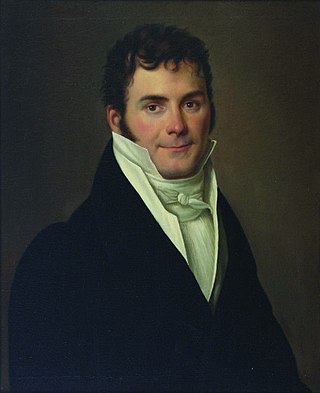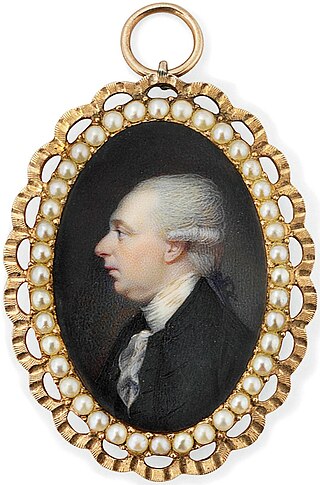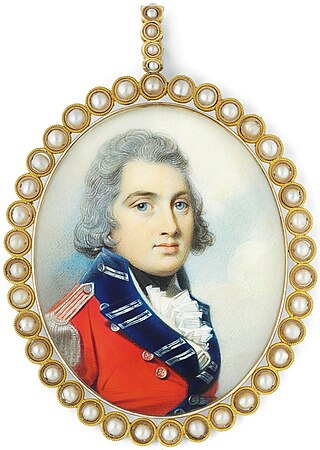
Mitchelstown is a town in the north of County Cork, Ireland with a population of over 3,740. It is situated in the valley to the south of the Galtee Mountains. Mitchelstown is 13 km south-west of the Mitchelstown Cave, 53 km north of Cork City, 56 km south-east of Limerick City and 15 km north of Fermoy. The town is close to the M8 motorway which links Cork and Dublin. Mitchelstown is considered one of the best examples of a Georgian planned town in Ireland. The River Gradoge runs by the town into the River Funshion, which in turn is a tributary of the River Blackwater. Mitchelstown is within the Dáil constituency of Cork East.

Earl Castle Stewart, in the County Tyrone, is a title in the Peerage of Ireland. It was created in 1800 for Andrew Thomas Stewart, 9th Baron Castle Stuart.

Earl of Meath is a title in the Peerage of Ireland. It was created in 1627 and is held by the head of the Brabazon family.

Earl of Kingston is a title in the Peerage of Ireland. It was created in 1768 for Edward King, 1st Viscount Kingston. The Earl holds the subsidiary titles Baron Kingston, of Rockingham in the County of Roscommon, Viscount Kingston, of Kingsborough in the County of Sligo, Baron Erris, of Boyle in the County of Roscommon, and Viscount Lorton, of Boyle in the County of Roscommon, also in the Peerage of Ireland. He is also a baronet in the Baronetage of Ireland. Between 1821 and 1869 the earls also held the title Baron Kingston, of Mitchelstown in the County of Cork, in the Peerage of the United Kingdom.

Earl of Rosse is a title that has been created twice in the Peerage of Ireland, both times for the Parsons family. "Rosse" refers to New Ross in County Wexford.

Mitchelstown Castle, the former home of the Anglo Irish Earls of Kingston, was located in the north County Cork town of Mitchelstown in Ireland.
Baron Kingston is a title that has been created twice in the Peerage of Ireland and once in the Peerage of the United Kingdom. The first creation came in 1660 when the military commander Sir John King was made Baron Kingston, of Kingston in the County of Dublin. He was the elder brother of Sir Robert King, 1st Baronet, of Boyle Abbey. Two of his sons, the second and third Barons, both succeeded in the title. The title became extinct in 1761 on the death of the latter's son, the fourth Baron, who had no surviving male issue. However, the title was revived three years later when his kinsman Sir Edward King, 5th Baronet, of Boyle Abbey, was made Baron Kingston, of Rockingham in the County of Roscommon. He was also created Viscount Kingston in 1766 and Earl of Kingston in 1768.

William George Hay, 18th Earl of Erroll, KT, GCH, PC, styled Lord Hay between 1815 and 1819, was a Scottish peer and politician.

Lieutenant-Colonel Henry Ernest Newcomen King-Tenison, 8th Earl of Kingston was an Irish peer and Conservative politician.
James Barry, 1st Baron Barry of Santry PC (Ire) (1603–1673) was an Irish lawyer, judge and peer.

William Richard Annesley, 4th Earl Annesley, styled Viscount Glerawley until 1838, was an Irish-born British Conservative politician.

Robert Henry King, 4th Earl of Kingston, styled The Honourable Robert King until 1837 and Viscount Kingsborough between 1837 and 1839, was an Irish peer, soldier and Whig politician.
The Fenton Baronetcy, of Mitchelstown in the County of Cork, was a title in the Baronetage of Ireland. It was created on 22 July 1661 for Maurice Fenton. The baronetcy became extinct on 17 March 1670, with the death of his son William Fenton.
Colonel Richard Fitzgerald was an Irish Member of Parliament.

Stephen Moore, 1st Earl Mount Cashell PC, styled The Honourable Stephen Moore between 1764 and 1766 and known as The Viscount Mount Cashell between 1766 and 1781, was an Irish landowner and politician.

George King, 3rd Earl of Kingston, styled Viscount Kingsborough from 1797 to 1799, was an Irish nobleman.
Edward King, 1st Earl of Kingston PC (I) was an Anglo-Irish politician and peer.

Robert King, 2nd Earl of Kingston was an Anglo-Irish peer. He was styled Viscount Kingsborough between 1768 and 1797. He achieved notoriety in 1798 when tried and acquitted by his peers in the Irish House of Lords for murder of his nephew Henry Fitzgerald. Fitzgerald had eloped with his daughter Mary.
Robert King, 6th Earl of Kingston, styled The Honourable until 1854, was an Anglo-Irish politician and peer.
Robert Dillon, 2nd Earl of RoscommonPC (Ire) was styled Baron Dillon of Kilkenny-West from 1622 to 1641 and succeeded his father only a year before his own death. He supported Strafford, Lord Deputy of Ireland, who appointed him keeper of the great seal. Dillon was in December 1640 for a short while a lord justice of Ireland together with Sir William Parsons.











